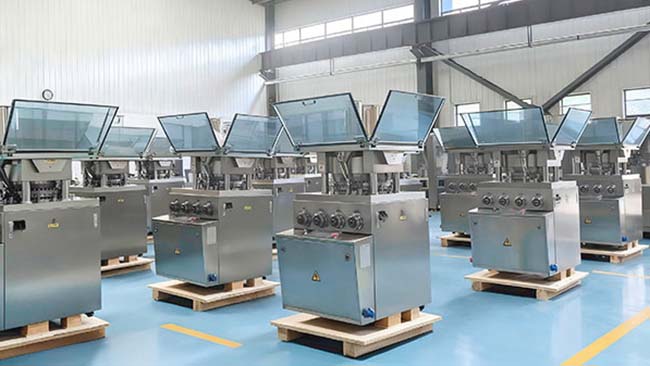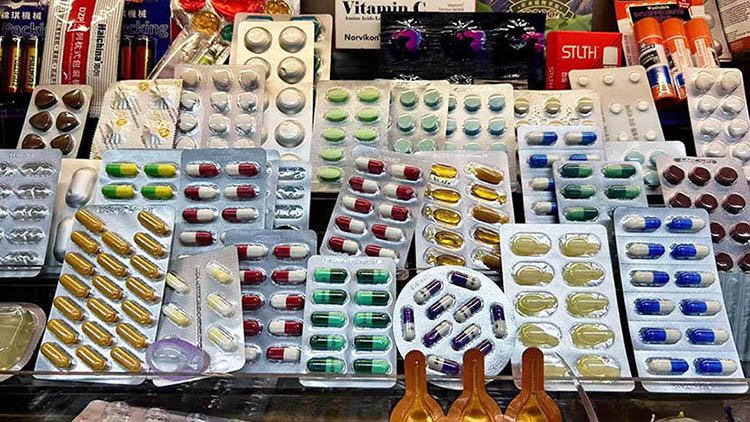After procuring a tablet press machine from China, have you ever faced the disappointment of your tablet pill press that fails to meet regulatory compliance, suffered from inconsistent tooling leading to unqualified quality of pharmaceutical tablets, or been plagued by unstable components that drive up maintenance costs and downtime?
Navigating the vast market for tablet pressing machines in China can be a challenging endeavor for pharmaceutical equipment buyers. With countless tablet pill press models and machinery suppliers, the risk of costly procurement missteps often exists.
To transform this challenge into an unfailing investment, you need a well-thought approach. For helping you avoid pitfalls when purchasing pharmaceutical machinery, we provide a definitive checklist outlining 4 critical considerations before selecting your tablet press machine:
1. Regulatory compliance with cGMP standards
2. A guarantee of weight uniformity of pharmaceutical tablets
3. Production capacity of your tablet compressor & hidden factors limiting the capacity
4. Safety and environmental friendliness
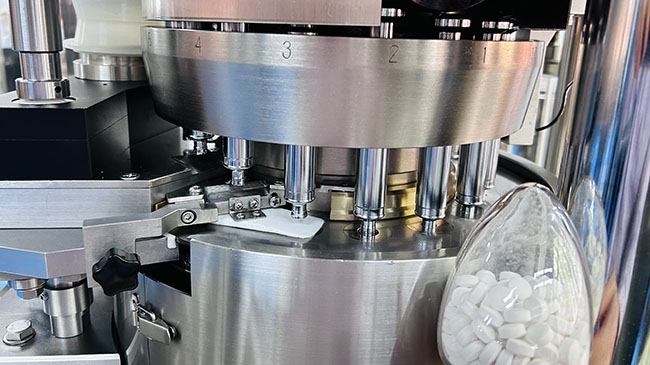
1. Is Your Tablet Press Machine cGMP Compliant?
Ensuring your press tablet machine adheres to cGMP standards is the most important consideration, for non-compliance equipment designs risk contamination on pharmaceutical tablets, regulatory actions, and costly product recalls, directly impacting patient safety and your brand’s integrity. cGMP compliance in a tablet pill press is built on three pillars:
● High-grade stainless steel utilization
● Hygienic machine designs with smooth, rounded corners, and easy disassembly for cleaning
● Access control, data integrity for traceable tablet production record
1.1 Strategic Stainless Steel Selection for Pharmaceutical Pill Presses
To meet cGMP requirements of being non-toxic, odorless, and corrosion-resistant, a press tablet machine must adopt quality stainless steel, eliminating paints or electroplating that will contaminate pharmaceutical tablets. This material adoption of a pharmaceutical tablets machine should incorporate stainless steel 304, stainless steel 316, and stainless steel 2Cr13.
| SS 304 | SS 316 | SS 2Cr13 | |
| Key Advantages | Moderate corrosion resistance, cost-effective | Resists strong corrosion, high-temperature stability | High strength, low cost |
| Key Drawbacks | Poor resistance to chloride environments | Higher cost | Poor corrosion resistance, difficult to machine |
| Typical Applications | Machine frames, kitchenware | Tooling of pharmaceutical or chemical processing equipment | Valves, high-strength mechanical parts |
● Stainless Steel 304
✜Anti-Corrosion & Plastic: Provides good corrosion resistance against a wide range of chemicals, easier to be shaped into complex structures.
✜응용 프로그램: Used for main structural and non-drug contact parts of a rotary tablet machine, including machine casings, frames, and covers.
● Stainless Steel 316
✜Enhanced Anti-corrosion: With the addition of molybdenum, SS316 enhances resistance to corrosive substances in active pharmaceutical ingredients.
✜응용 프로그램: For all parts in contact with raw ingredients, including feed hoppers, forced feeders for powder feeding, and tablet machine punches and dies.
● Stainless Steel 2Cr13
✜High-Strength: Has high surface hardness, durable and resistant to impact, heat, and abrasion from powdery and granular formulations.
✜응용 프로그램: Suited for components that may bear high pressure like the turret. Some advanced tablet compressors like HGZP 40D adopt SS2Cr13 to the turret material to ensure a long service life.
In a word, while SS304 forms the skeleton of a tablet pill making machine, all critical medication-contact surfaces must be manufactured from SS316 to guarantee the highest-level safety of pharmaceutical tablets. In addition, all product-contact parts should achieve a surface roughness of Ra≤0.4μm, preventing powder adhesion and potential microbial growth.
1.2 Hygienic Design in Tablet Making Machines
Hygienic design of a pill press machine entails a large-platform, easy-to-clean construction. Key elements that define such a design include powder recovery mechanisms, powder retaining plates, and built-in dust extractors, with the purpose of controlling powder dispersion.
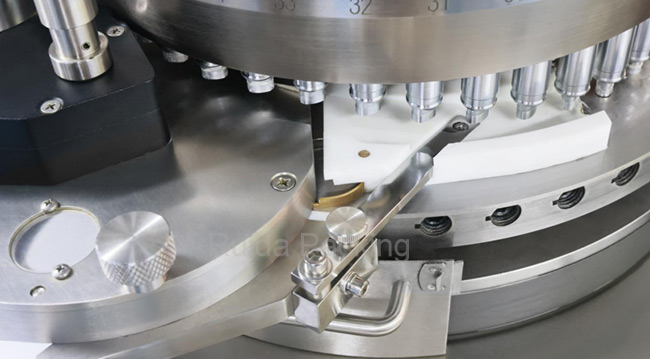
●Large-platform Design: The foundation of this hygiene is a large-platform design free of sharp corners and hidden gaps. This structure ensures every surface is accessible for removing contaminants, thereby reducing cross-contamination.
●피owder Recovery Device: An intelligent tablet press machine has a powder recycling device. Utilizing the main turret’s rotation, the device captures residual powder back to a recovery channel for reuse, ensuring a turret surface with less powder residue.
●Powder Retaining Plate: Be positioned between the forced feeder and the point where upper punches descend into die bores, preventing powder from being ejected from die holes and contributing to environmentally friendly tablet compression.
●Built-in Dust Collectors: With suction ports positioned above and below the turret, integrated dust collectors actively draw in airborne particles, upholding the required environmental standards for pharmaceutical tablet production.
1.3 Data Integrity and Traceability
In modern tablet manufacturing, data integrity and traceability are non-negotiable functions to meet regulatory compliance of EU GMP Annex 11 and FDA 21 CFR Part 11. It’s achieved through access control, audit trail, and e-signatures.
●Access Control: Guarantees restricted access according to different users’ roles. This prevents unauthorized changes to critical parameters like tablet compression force. Only qualified personnel can modify tableting settings in order to protect tablet production safety and consistency.
●Audit Trail: An automated log that continuously documents all e-records. Any change to tablet compression recipes, calibration, or parameters is captured, essential for regulatory audits, accountability inquiry, and equipment troubleshooting.
●Electronic Signatures: When a batch of tablet production record is complete, a responsible supervisor can electronically sign it, linking their identity to the approval and confirming all data and the audit trail have been reviewed for compliance.
In strict tablet manufacturing, an intelligent data system of a GMP tablets press machine such as HGZP-26D ensures every action and parameter setting related to a tablet production batch is accurately recorded and traceable.
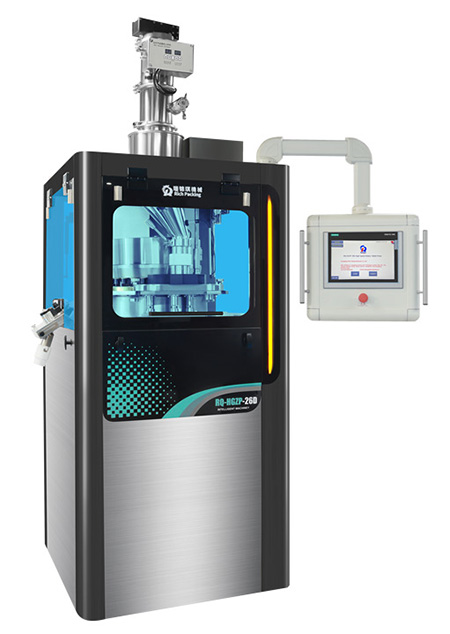
2. Can Your Pill Pressing Machine Maintain Uniform Tablet Weight?
Imagine that pharmaceutical tablets weigh differently. What a nightmare for drug effects and patient safety. Maintaining uniform tablet weight guarantees precise dosage, therapeutic efficacy of medications, and regulatory compliance. In a pharmaceutical tablet pill press, tablet weight uniformity is achieved through precisely machined tooling, efficient forced feeders, and real-time tablet weight monitoring systems.
2.1 Key to Uniform Pharmaceutical 정제: 기계적인 Precision & Efficiency
Precision tooling alongside an efficient forced feeder are the primary determinant of tablet weight uniformity.
●정도 Tooling: Consistent tablet weight starts with precisely machined punches and dies. When punches and dies are manufactured to extremely tight tolerances with consistent mold dimensions and optimal clearances, they create a uniform die cavity volume for each tablet compression cycle, leading to the same amount of powder compressed by upper and lower punches in each die hole.
●High-Efficiency Forced Feeders: A uniform die cavity volume alone is insufficient. For consistent powder feeding, an efficient forced feeder proves indispensable. It actively forces powder into die cavities, and eliminates air gaps or uneven powder density that may occur with normal gravity feeders, safeguarding tablet weight consistency.
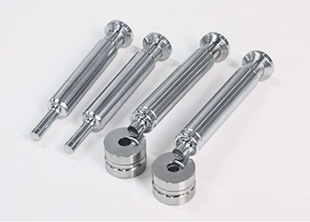
2.2 Beyond Mechanical Precision: The Role of Real-Time Monitoring in Tablet Weight Control
While precision tooling sets the foundation of consistent tablet weight, keeping this standard at high tablet compression speeds requires real-time monitoring. Modern tablet pill press machines incorporate real-time tablet weight control systems that function through 3 key components: a pressure deviation monitor to detect compression force anomalies, powder fill depth control to make immediate fill volume adjustments, and an out-of-spec tablet rejection system.
●Real-Time Pressure Monitoring: Through sensors installed on the main compression roll shaft and lower punches, the system actively monitors the pressure exerted on every single tablet. This allows for real-time tracking of the compression force for each punch, enabling immediate pressure deviation detection.
●Automated Fill Depth Control: Based on the feedback of punch pressure, if the monitor detects any deviation from the preset pressure value, this signals potential variation in tablet weight, because a higher powder fill volume in die cavities requires higher pressure. Instantly, the system sends a command to a servo motor which finely adjusts the movement depth of lower punches. This adjustment alters the powder fill volume, thereby correcting tablet weight in real time.
●Real-time Waste Rejection 에스ystem: Through this system, any deviation from the set pressure parameter will be automatically identified as the production of a non-conforming tablet. The system then precisely rejects finished tablets of unqualified weight. This process enables continuous or single-piece rejection of underweight or overweight pharmaceutical tablets, safeguarding dosage accuracy throughout the entire batch.
The auto tablet weight control system stands as the guardian of dosage uniformity, essential for a tablet press machine adhering to stringent tablet manufacturing standards.
3. Considering Tablet Machine Output: What Are Constraints and Solutions
In terms of production capacity of a pharmaceutical tablet press machine, the obvious difference in output—from 8,000 to 350,000 tablets per hour—directly correlates to the scale and ambition of your tablet production, hence the necessity of assessing your required pill production capacity.
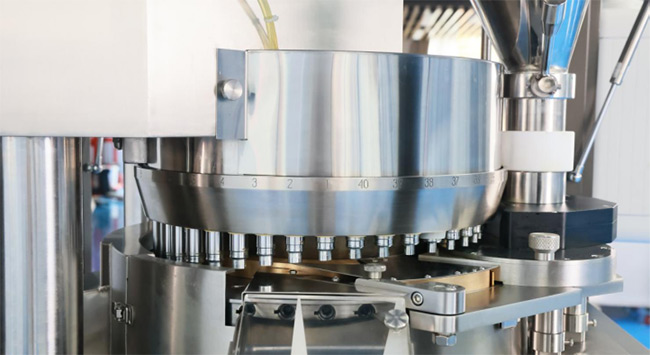
3.1 Theoretical Capacity VS Actual Capacity
A reminding for every pill press buyer is to look beyond suppliers’ theoretical output.The maximum output of a tablet pill press, often based on turret speed, is rarely achieved in practice due to several constraints:
●Raw Ingredient 기음haracteristics: Powder with poor flowability may not fill die cavities rapidly or uniformly at high speeds, forcing a reduction in tablet compression speed to maintain weight consistency of pharmaceutical tablets.
●Tablet 디esign: Larger or thicker tablets require longer compression dwell time and can limit the achievable production speed, and some irregularly shaped tablets with edges, corners, and curved surfaces will exhaust more production time.
●Product Change & Downtime: Manufacturers will need to produce kinds of pharmaceutical tablets and pills. For product change, tooling changeover and equipment cleaning increase the downtime of your 고속 태블릿 프레스 기계.
A practical method to understand the actual production capacity of an automated tablet machine is to have a real-world trial run with the target machine and your raw ingredient.
3.2 Tactics to Minimize Tablet Compressor Downtime
Facing constraints of production capacity mentioned above, reducing machine downtime is the proactive measure that a tablet pill making machine is supposed to bring about.
Minimizing downtime of your auto tablet press machine is crucial for maximizing productivity. While choosing your tablet compression machine, you are supposed to consider the following strategic design characteristics.
●Digital Setup & Recipe Management: A user-friendly human machine interface (HMI) allows operators to store and label all tablet compression parameters for different products. This enables one-touch recipe utilization, eliminating manual adjustments that cause errors and prolonged downtime.
●Modular Design & Quick-Release Molds: For pressing kinds of tablets, a modular design is essential. Components like the feed hopper, punches, dies, and discharge chutes should enable rapid disassembly for easy cleaning, so as to reduce cleaning and setup time between tablet production batches.
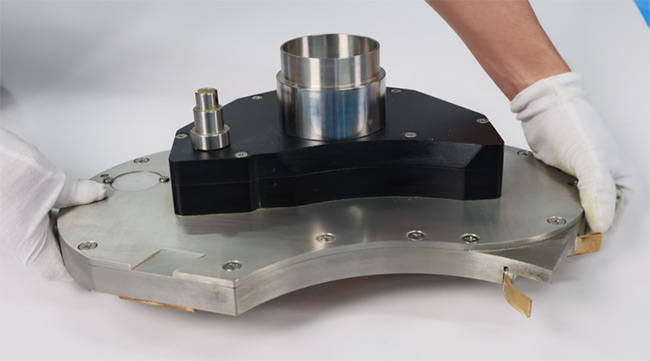
Moreover, you had better pay attention to tooling compatibility that makes sure your pill presser uses standardized molds to avoid long lead times and dependency on one single supplier. In the aspect of maintenance, a scheduled program for inspecting and replacing worn parts such as punches, dies, and compression rolls can prevent unexpected failures.
4. cGMP Essential: Does Your Tablet Compression Machine Meet Safety and Environmental Compliance?
A pill press machine’s adherence to safety and environmental standards is a fundamental aspect to uphold cGMP compliance and sustainable tablet manufacturing. cGMP standards mandate proactive approaches to risk management, which encompass:
●Protecting operator safety through safety devices and alerts
●Unfailing component quality
●Environmental protection through responsible operational practices
4.1 Operator Safety: Essential Mechanical Protections in Tablet Presses
Mechanical safety features of a tablet pill press encompass built-in safeguards designed to protect operators from injury during tablet compression operation, equipment maintenance, and cleaning.
●Safety Door: Primary protection is provided by safety doors with interlock switches, which physically prevent access to the tablet compression zone while the machine is running, and halt operation if a door is opened.
●Emergency Stop Buttons: Be positioned at strategic locations, enabling immediate machine shutdown in any hazardous situation to minimize user safety risk.
●Safety Monitoring and Alarm System: Continuously scans the status of your rotary pill press. The system detects anomalies such as pressure overload during tablet compression, motor overload from mechanical obstruction, and abnormal vibration in punch guide rails. By providing early warnings and automatic stops, this system prevents catastrophic failures that endanger personnel and the automatic pill press.
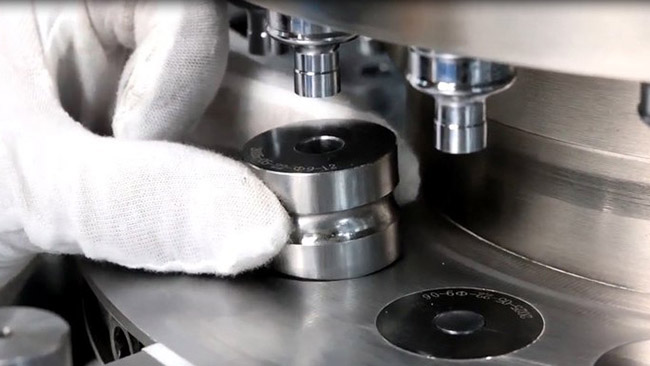
●Precision Mold Machining & Single-hand Mold Change: Does machining of pill press tooling matter with operator safety? It turns out to be a YES. Owing to the extremely high precision and compatibility between the turret and dies, automated tablet press machines such as HGZP-17D enable tool-free mold changeover within 30 minutes. Operators don’t need hammers or special tools when they change over dies and punches, minimizing the risk of being injured when using complicated tools to perform exhausting mold change.
4.2 Environmental-friendly Designs of Automatic Tablet Pressing Machines
This kind of design is a critical aspect of sustainable pharmaceutical tablet manufacturing. This holistic approach comprises 3 key areas: noise pollution control, energy consumption saving, and lubricant contamination reduction.
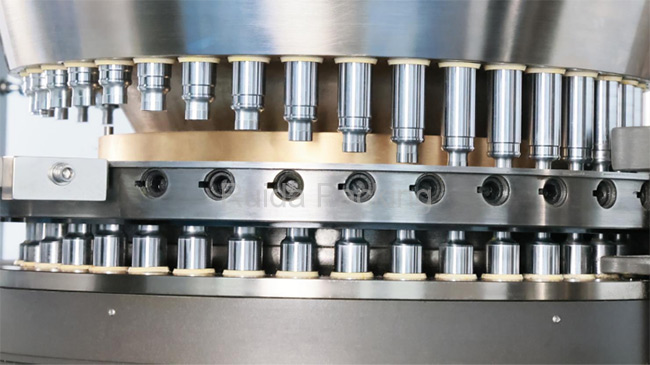
●Noise Control
Advanced noise reduction is achieved through multiple engineered solutions.
✜Acoustic Enclosure: Surrounds the tablet compression zone, effectively containing sound waves at their source.
✜에프lexible Damping Elements: The elements are fitted around punches, and act as energy absorbers; the elastic material dampens the vibration transmitted via the tablet compress machine frame, preventing vibration from converting into airborne noise.
✜중agnetic Damping Elements: These elements provide a contactless braking effect. By installing fixed magnets near ends of punches’ travel paths and corresponding magnets on punches themselves, the resulting repulsive force creates a gradual deceleration for punches. This “soft stop” prevents the impact noise generated from mechanical collisions.
●Energy Consumption Saving
By employing servo motors, advanced medicine tablet machines minimize electricity usage. In line with a document delivered by the U.S. Department of Energy, adopting advanced servo technologies in industrial machinery can lead to energy savings of 15-35% compared to traditional asynchronous motors. This is achieved via servo motors’ power-on-demand functionality.
●Lubricant Contamination Prevention
With the help of intelligent lubrication systems, the risk of lubricant overuse and spillage is mitigated. These systems deliver precise, metered amounts of lubricant to critical transmission components like compression wheels, guide rails, and gear shafts only when required. This targeted approach prevents the excessive oil and grease application common in manual lubrication, thereby reducing lubricant waste and the potential contamination on medication tablets.
마지막 말
Before you procure a tablet press machine, look beyond the initial price. A thorough evaluation of cGMP compliance, tablet weight control, operational efficiency, built-in intelligent designs, and safety protection is crucial. Prioritizing these key areas will guide you to a tablet pill press that ensures quality of pharmaceutical tablets, maximizes uptime, and delivers long-term value.
